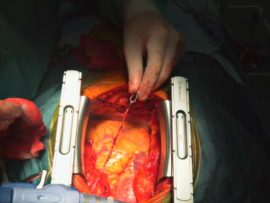Abstract Introduction Genetic polymorphisms are important in explaining the wide interpatient variability that exists in the development of acute kidney injury (AKI) post cardiac surgery. We hypothesised that polymorphisms in..
Read MoreAbstract Summary Few studies have investigated if, and how, red cell transfusion and anaemia interact. We analysed 60,955 admissions to three metropolitan hospitals in Western Australia between 2008 and 2017..
Read MoreAbstract Background: Extracorporeal carbon dioxide removal may be used to manage hypercapnia, but compared to dialysis, it’s not widely available. A recent in vitro study showed that dialysis with low bicarbonate dialysates..
Read MoreAbstract OBJECTIVES: The upcoming release of aprotinin in paediatric cardiac surgery prompted a re-evaluation of its use in comparison to tranexamic acid (TXA) focusing on their effect on exposure to..
Read MoreAbstract Background (MP) has been reported as a possibly method to rescue discarded organs. The main aim of this study was to report an initial experience in Spain using MP..
Read MoreAbstract OBJECTIVES Although reduced lung function and chronic obstructive pulmonary disease (COPD) is associated with higher risk of death following cardiac surgery, preoperative spirometry is not performed routinely. The aim..
Read MoreAbstract Introduction: We have been developing a closed-circuit cardiopulmonary bypass (CPB) system (“Dihead CPB”) for application during coronary artery bypass grafting (CABG) and valve surgery. To strive for minimal hemolysis..
Read MoreAbstract Background: Cardiopulmonary bypass and postoperative cardiac dysfunction cause splanchnic hypoperfusion resulting in intra-abdominal anaerobic metabolism and risk for gastrointestinal complications. The intra-abdominal metabolism can be monitored by intraperitoneal measurement..
Read MoreAbstract BACKGROUND Volatile (inhaled) anesthetic agents have cardioprotective effects, which might improve clinical outcomes in patients undergoing coronary-artery bypass grafting (CABG). METHODS We conducted a pragmatic, multicenter, single-blind, controlled trial..
Read MoreAbstract Background Brain injury and cognitive dysfunction are serious complications after cardiac surgery. In the perfusion pressure cerebral infarcts (PPCI) trial, we allocated cardiac surgery patients to a mean arterial..
Read MoreAbstract Purpose The Nova StatStrip® Glucose Hospital Meter System (Nova Biomedical, Waltham, MA, USA) is United States Food and Drug Administration approved for point-of-care use in critically ill patients, but..
Read MoreAbstract OBJECTIVES Between 2% and 8% of patients return to the theatre for mediastinal bleeding following cardiac surgery. In the majority of patients, a surgical source of bleeding is identified...
Read MoreAbstract (ECMO) is a form of (ECLS) which is used frequently in the paediatric and neonatal setting to support either the pulmonary, or both the pulmonary and . Management of ECMO requires..
Read MoreAbstract In thromboelastometry (ROTEMTM) the difference in amplitude between the EXTEM and the FIBTEM is considered an index of platelet contribution to clot strength (PCSamp). The difference in elasticity (PCSel)..
Read MoreAbstract Objectives Prolonged (CPB) is recognized as a risk factor for (ARF), but the dose effect of time on bypass is unknown. We therefore examined the risk of ARF associated with increasing..
Read MoreAbstract Acute kidney injury is a common and serious complication after congenital heart surgery, particularly among infants. This comorbidity has been independently associated with adverse outcomes including an increase in..
Read MoreAbstract Purpose of Review This paper will discuss current cannulation strategies for infant aortic arch repair and compare them to more traditionally used techniques. Recent Findings Aortic arch reconstruction in..
Read MoreAbstract Background: The aim of the study was to evaluate the effects of high-dose nitroglycerine administered during cardiopulmonary bypass on the intraoperative cerebral saturation and postoperative serum creatinine concentration in..
Read MoreAbstract Malignant hyperthermia is a well-known but potentially lethal disorder which is triggered by volatile anesthetics and depolarizing muscle relaxants. Early diagnosis and treatment could save lives. However, during cardiac..
Read MoreAbstract We describe a quality improvement initiative aimed at achieving interdisciplinary consensus about the appropriate delivery of extracorporeal membrane oxygenation (ECMO). Interdisciplinary rounds were implemented for all patients on ECMO..
Read MoreAbstract Objective: To describe neurobehavioral outcomes and investigate factors associated with survival and survival with good neurobehavioral outcome 1 year after in-hospital cardiac arrest for children who received extracorporeal cardiopulmonary..
Read MoreAbstract Aim Although recent (CA) trials found no benefits of versus normothermia , preclinical models suggest earlier timing of hypothermia improves efficacy. This study investigated whether shorter time to goal temperature was associated with..
Read MoreAbstract Objective To determine whether a continuous of standard amino acids could preserve kidney function after on-pump cardiac surgery. Methods Adult patients scheduled to receive cardiac surgery lasting longer than 1 hour..
Read MoreAbstract Background There is an increasing number of young adults living with (CHD). The goal of this study was to ascertain the frequency of (AKI) as well as the risk factors and..
Read MoreAbstract Essentials Strategies to improve platelet function may reduce excessive bleeding during cardiac surgery. Patients were randomized to standard care or standard care + noradrenaline infusion. Low‐dose noradrenaline improved intraoperative..
Read MoreAbstract Perfusion strategies for have direct consequences on pediatric cardiac surgery outcomes. However, inconsistent study results and a lack of uniform evidence-based guidelines for pediatric cardiopulmonary bypass management have led to..
Read MoreAbstract Background During cold storage, some red blood cell (RBC) units age more rapidly than others. Yet, the Food and Drug Administration has set a uniform storage limit of 42..
Read MoreAbstract Background and Aim of the Study Extracorporeal life support (ECLS) may be necessary in refractory postcardiotomy cardiogenic shock (PCS) unresponsive to optimal medical treatment. We sought to analyze the..
Read MoreAbstract Central venoarterial extracorporeal membrane oxygenation has been used since the 1970s to support patients with cardiogenic shock following cardiac surgery. Despite this, in-hospital mortality is still high, and although..
Read More










